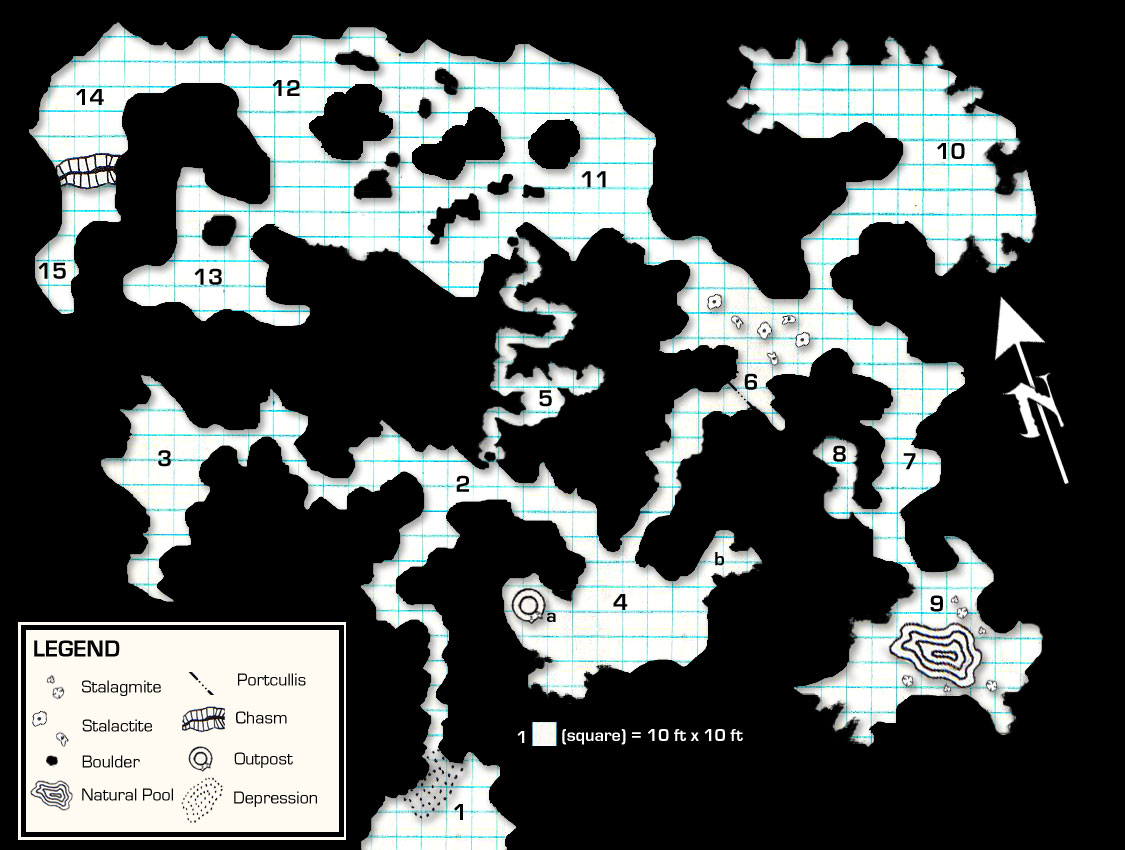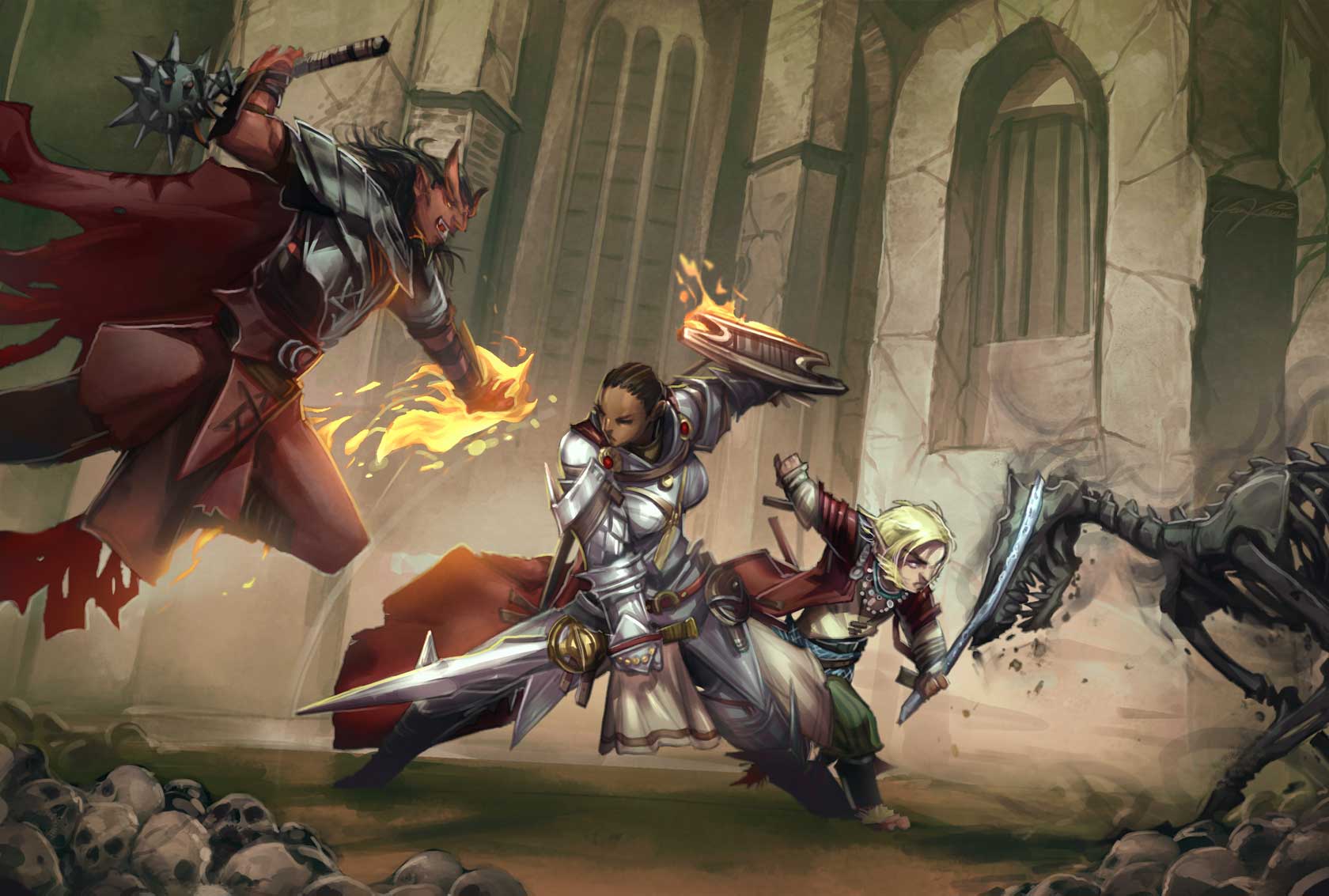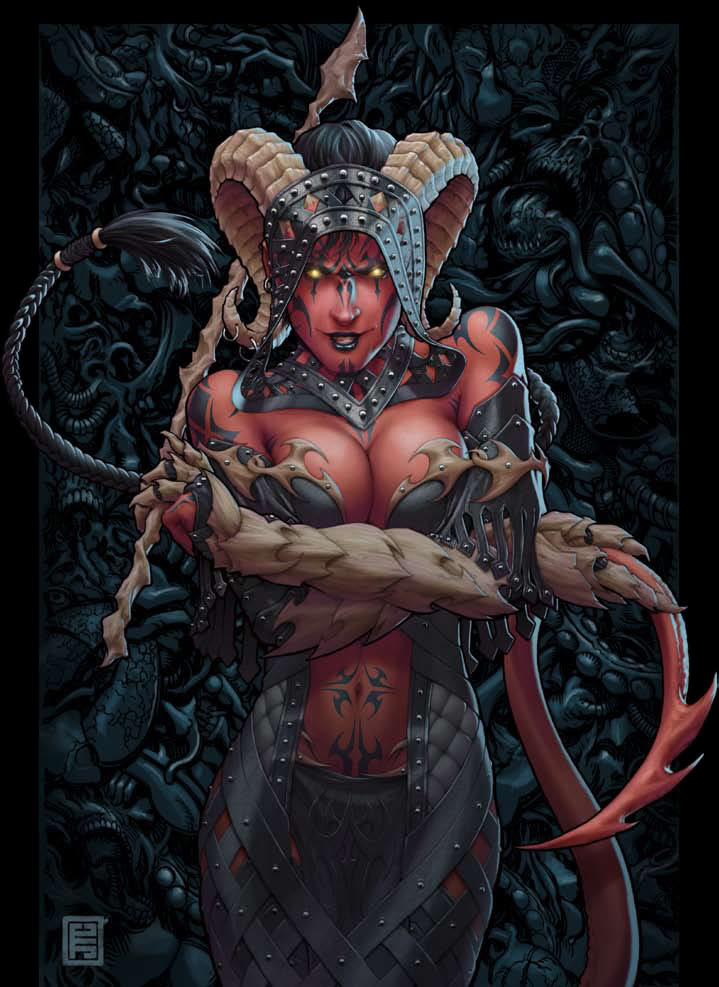I haven't put any useful or fun game stuff in the blog lately, so here I offer a recent dungeon delve I designed using
"Engineering Dungeons" for Castles & Crusades. ED is a great toolkit book, and useful for any dungeon-delve style game, not just C&C; I recently ordered the sequel,
"Engineering Castles" from the Trolls and eagerly await my copy.
The adventure below is written for C&C, and uses a map provided online by Tim Hartlins under a
creative commons license here (check it out if you haven't already, he does great maps!) It would be very easy to adapt this dungeon to Swords & Wizardry or any other OSR game. Characters of levels 2-4 will find the greatest challenge within, although if they aren't sufficiently equipped to deal with the hydra or the roper they may find those two monsters deadly (in my one-shot run of this the hydra was easily defeated but the roper got the jump on the party and it almost turned into a TPK!)

The Lair of Gug and the Lost Shrine of Degalthor
Location: Western Golmadras (set in the Warlords era of Lingusia, ca. 3500 a.w.; but easily inserted anywhere else desired)
Purpose of the Dungeon: serves as a shelter to local denizens
Builders: this is a natural cavern
Location: deep in a range of low hills in the swampy jungle-lands of the Flooded western Goblin Marshes
Depth: 1 level
Entrance: The entrance is both unknown and hidden; locals know of the cave, but not of its entrance or how to find it.
History/Age: the cavern has been used or known of for at least three thousand years. The first occupants of the cavern were troglodytes, but long ago they were driven from the cave when a cult of Degalthor, the deviant goblin god inserted themselves within. The cult was active for centuries until a contingent of elvish knight-adventurers in the old days of lost Sylvias arrived and destroyed the cult. Since then the cavern has lain fallow, used by rogue gangs of humanoids as a base and errant monsters as a den.
Start: About thirty miles south in the port town of Kharamish Sheriff Jaravas is aware that the bandit gang of the ogre Gug has been operating in the north hills of the swamplands, but he is at a loss as to their location. He has a reward out for Gug's head (250 gold pieces). Sheriff Jaravas does know that a local hermit named Khromas, who lives in the swamps, may actually know of Gug's lair, as he recently caught the hermit trying to fence goods in the town market; he suspects that the hermit has a deal going with the ogre.
Finding Khromas's hut is easy enough, but the hermit initially won't talk. Khromas is 83 years old, but long ago was a disgraced knight of the Golmadran army, and this is where he has ended up. Appealing to his lost honor (Wis check CL +2 to notice this weakness in his personality) may open him up to revealing the trail to the lost cavern. Failing that, ransacking his hut will reveal an old map that marks the entrance location.
1. Entrance
This sloping chamber induces a sense of vertigo as the natural formations of the cave are skewed unnaturally. Three skeletons lie near an ancient, heavy chest that appears to have been dragged here by the trio, who then mysteriously died. The best is heavy, and a thick iron key sits rusted in the lock (Strength check to force it to turn and open; CC+2 to break the chest open). The chest contains 1300 GP, 11 random gems, 10 extraordinary items, and a ring of telekinesis.
Amazingly, no one has tried to loot this chest; a Tracking check (CL +3) reveals that there are a variety of humanoid and animal prints that go well around the chest. Unknown to the adventurers, unless they diplomatically talk to some of the denizens of this cavern, the local inhabitants are all quite supersititious and convinced that the chest is laden with deadly traps. This is in fact true, but it was a one-time trap tripped three decades ago, and it has lain dormant ever since.
2. Split in Passage
Trundling through the dark cavern is a nesting hydra (10 HD)! It will be attracted by the noise of the adventurers entering the cavern, although if they were sufficiently stealthy (CC +10) then they may surprise the beast:
10 headed Hydra (HP 40; 10 HD; +10 attacks and Saves; AC 20; Individual Head HP: 6,1,6,2,3,6,4,2,4,6; Attacks: Bite 1D10; XP Value 3250)
3. Hydra Lair
Seven orcs are here, trying to loot the Hydra lair while they know it is preoccupied with the adventurers! The hydra’s nest is made up of garbage and debris, like it was nesting, and the treasure is scattered haphazardly among the bones of victims.
Orcs 1 HD; HP 6, 7, 4, 3, 8, 2, 2 (67 XP total) armed with axes (1d8) and short bows (1D6)
Treasure: 220 gold pieces, Delay Poison Potion, several rusty swords, arrows and rotted bows.
4. Old Shrine
The entrance to this chamber is protected by a naturally concealed pit trap. This is not accessible (can’t be defused) and is not visible (Traps check to spot at CL +3), as the orcs in this area have covered it with a canvas tarp, and then sprinkled dirt on the tarp to conceal the pit; it is lethal and 40 feet deep (10D6 falling damage) CC +3 vs. Dexterity to grab the edge and avoid falling in!
Within the chamber is a squat, vile idol to an unknown demon god of old, probably Degalthor, a foul object of goblin worship. The idol resembles a cross between a mutated goblin and a deformed imp with frog-like qualities. It has long since been stripped of valuables, and there are numerous empty sockets on the statue where precious stones have been pried loose. Evidence of orcs having camped here is found on the ground.
Area A: The altar.
Area B: Thick visible spider webs, immobilizing, CL +2 to avoid or break free from. These can be ignited. If the webs are cleared, a cocooned victim can be found in the back, mummified and dead. This man was wrapped with armor and weapons; he wore a chain shirt and had an expert-quality broadsword. A pouch is rotted away but 8 copper pieces can be found on the ground, and remnants of what was possibly an old treasure map.
5. Narrow Passage
This narrow passage connects two different areas of the cavern; there is a slight chance that one of the orcs in area 11 may be wandering down the passage either on guard duty or to relieve himself.
6. Abandoned cavern
The entrance is blocked by an old heavy oaken door with a thick lock that has been oiled by local denizens (CL +2 to pick). The natural cavern beyond is filled with old litter and debris from previous orc or goblin encampments, but is abandoned.
7. 8. And 9. Empty
These chambers are not normally in use, but there is always a 25% chance of a wandering monster or denizen squatters being present.
10. Lair of the Roper
This wide, dark chamber initially looks safe, although crowded with stalagmites and stalactites producing various beautiful natural formations. One of these stalactites is not quite what it seems, however! The roper hangs from the ceiling, stealthed (CL +7 to spot Wis check), and readies for an attack.
Roper 7HD (47 HP) AC 24 SR 4 (1409 XP)
Treasure: strewn about in the back, where the remains of digested victims can be found. 1400 gold pieces, 10 pearls (15 gp each) in its gullet, and various mostly rusted and useless items.
The orcs have been well aware of the threat of the roper, and have used periodically to get rid of the rare prisoner or rival monster that they must deal with.
11. Orcish Encampment
Here are more orcs, using this safe area of the cavern as a refuge. They are dominated by one ogre of local repute named Gug. (217 XP)
Gug the Ogre: HD 4; HP 25 (2H Sword 2D6+3); Eight Orcs: HD 1; HP 8,7 3, 3, 7, 6, 1, 2 (battle axes 1D8)
Treasure: The orcs have a grand total of 40 gold pieces, 4 bloodstones worth 50 gp each and a fine belt with a wooden buckle worth 50 GP. One orc has a scroll with one 1st level spell on it (invisibility to undead). The Ogre has 180 gold pieces, an expert 2H sword, an expert battle axe on his belt, and a wooden urn full of one dozen expert arrows.
Gug is a known criminal and bandit in the region, and his gang is known as Gug’s Raiders. There is a 250 gold piece bounty on his head in the nearby town of Kharamish.
12. Cavern of Echoes
Nothing resides in the western stretch of cavern save bats and eerie echoes of those passing through.
13. Abandoned Wing
This chamber is empty. Strange smells and debris suggest it long ago served as a den of an unknown monster that likely moved or was slain when the orcs arrived.
14. Collapsing Cavern
This unstable cavern is crisscrossed by a collapsed floor chasm, and the ceiling is unstable (Int, stone cunning or Traps check CL -2 to notice the danger). Noise sets it off, but darting out before an avalanche of stone crushes anyone is easy (CL-2 vs. Dex to get away; 4D6 damage to those caught under the crushing stones).
15. Treasure Chamber
This chamber was established as the reserve for Gug’s loot. He is aware of the prior chamber’s structural instability, and so moves very carefully through the chamber. Here he has placed the following loot gathered from raids on caravans in the region:
8 bolts of fine Takkain silk
10 crates of Etrurian fine port wine (12 bottles to a crate)
356 gold pieces in loose change
4 expert quality long swords and 1 expert quality suit of platemail…slightly dented, with a skeleton inside from the prior owner
A Wand of Magic Missles (none of the orcs or Gug could figure out how to activate it)
A single crate of healing potions (Gug knows what these are; there are 7 left)
















































